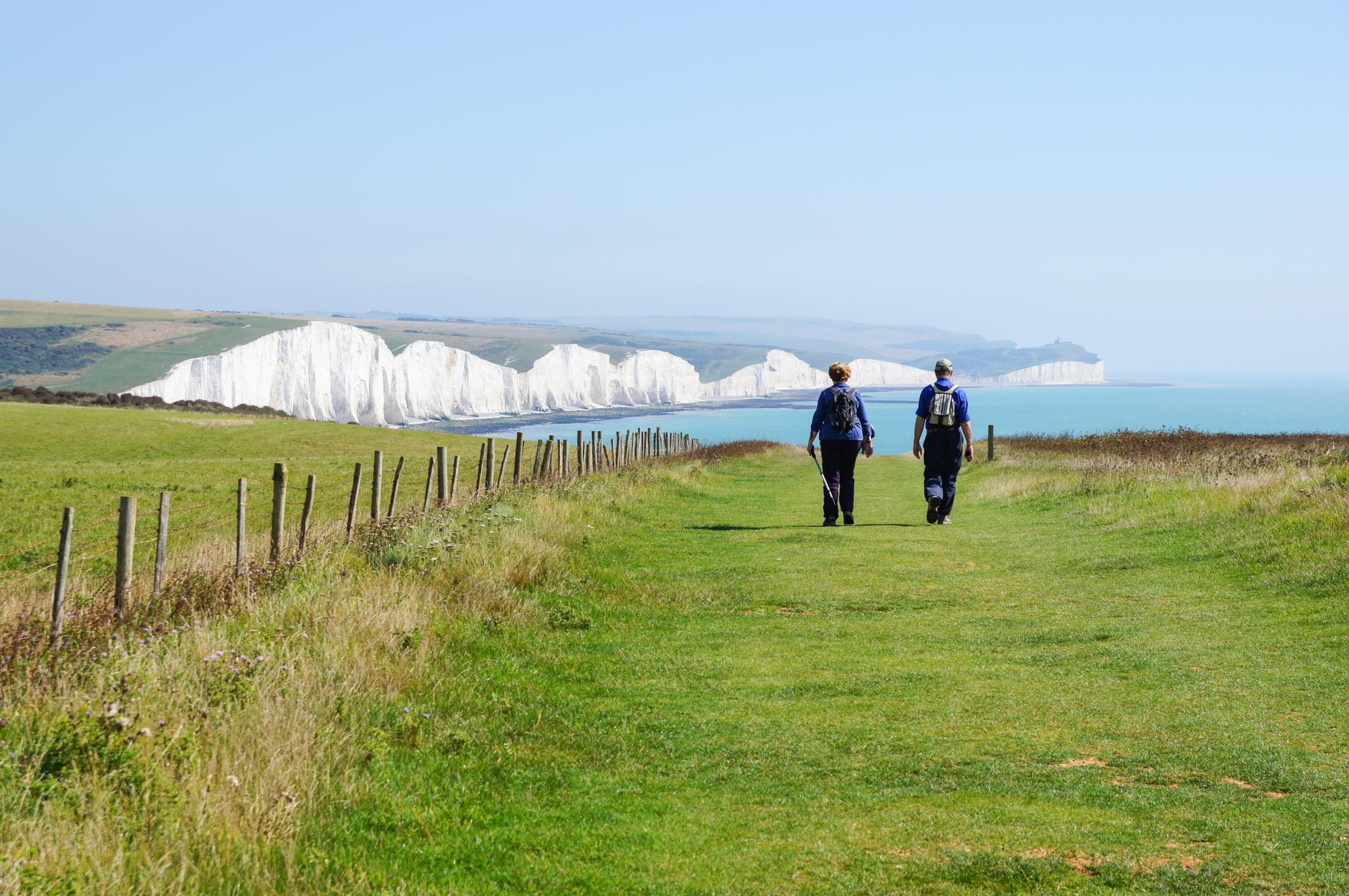
Route Overview
Where is the South Downs Way?
The South Downs Way stretches for 160km (100 miles) along the rolling chalk hills of the South Downs, one of the most important chalk landscapes in England and quite possibly, the world. Travel the length of the South Downs Way and behold interesting wildlife, pre-historic relics, wonderful pubs and pretty villages. The South Downs Way route follows the old trails and drove ways along the chalk escarpment and ridges of the South Downs.
Why should you walk the South Downs Way?
Dust off those walking boots and set foot on the beautiful South Downs Way. Whether you are an experienced walker wanting to complete the trail in a short space of time or prefer a more gentle wander through the rolling hills, this is the ideal route for you. The trail is considered to be one of the most scenic coastal paths in the UK with a mixture of colourful forestry and moorland to magnificent coastal edges.
This National Trail offers visitors a haven that seems a million miles away from the hustle and bustle of modern life, yet remains only minutes from civilisation. The meandering route provides a wonderful trip for long distance walkers looking for an exciting short break. The trail gives a taster of the surrounding landscapes ahead, with spectacular views, wildflower meadows, old woodlands and charming villages. The area is steeped in history, extending from the Stone-age and Iron-age to the Norman age and beyond.
The route starts in the historic city of Winchester and finishes at the fresh Victorian seaside town of Eastbourne located next to the stunning white cliffs of Beachy Head.
The entire route lies within the South Downs National Park, England’s newest national park, and the area is renowned for the natural beauty, wildlife and cultural heritage of the downland environment.
Highlights of the route include Winchester, with its 2000 years of history and spectacular cathedral, the Iron Age hill forts at Old Winchester Hill and Chanctonbury Ring, the quintessential English villages of Amberley and Alfriston, the Devil’s Dyke dry valley, the wide ranging views from the many viewpoints along the top of Downs and, of course, the glorious chalk cliffs of the Seven Sisters and Beachy Head.
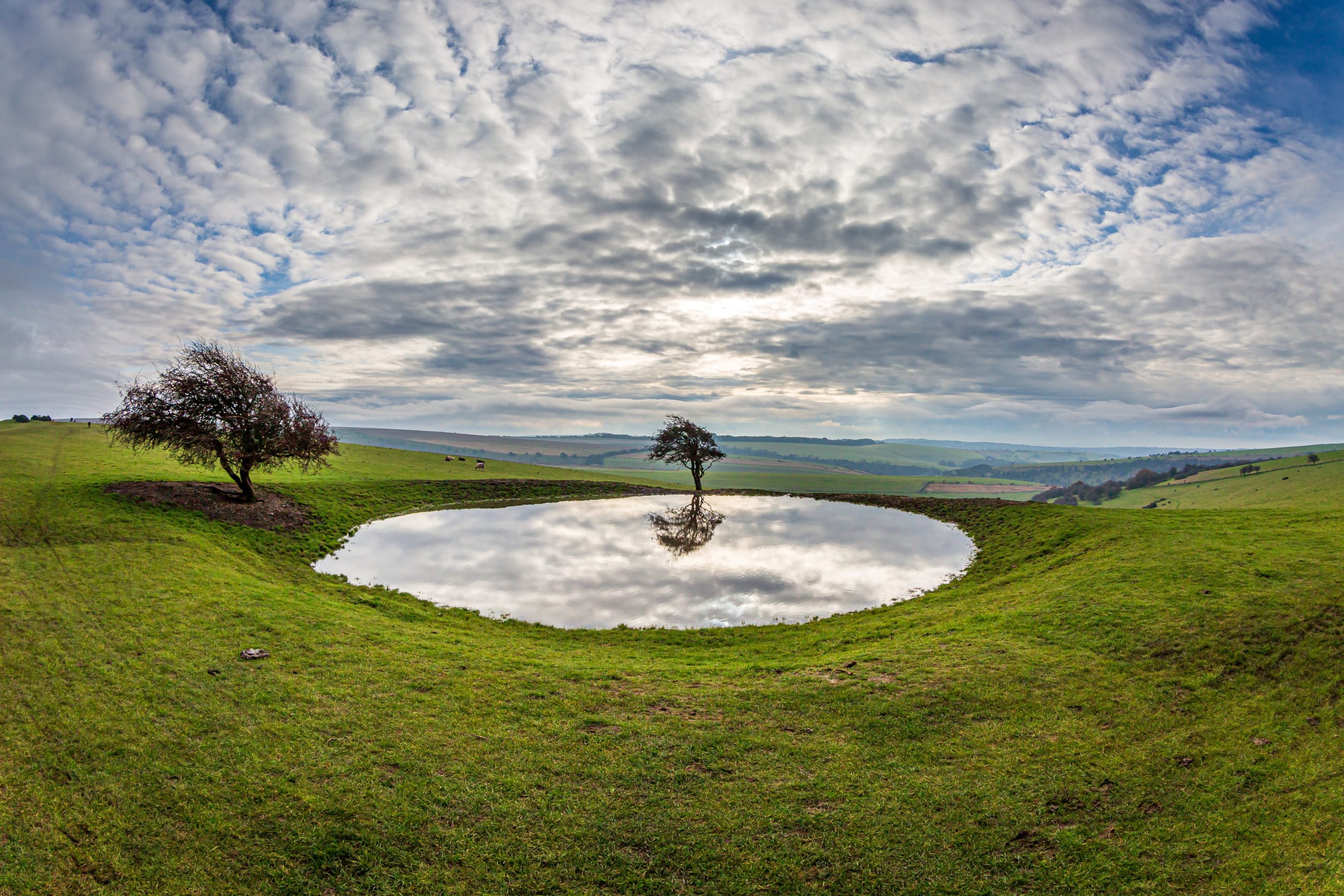
When is the best time to walk the South Downs Way?
When booking a hiking holiday, every season has its own charm, but indeed some months are better for hiking than others. It is always important to make yourself aware of the best times to walk any long-distance trails as weather conditions and busyness can greatly impact your overall hiking experience.
Of course, hours of sunshine, probability of rain, wind and temperature depend solely on the respective season in England.
Due to the longer daylight hours and more favourable weather conditions we recommend that you visit the South Downs Way anytime from March through to October. If you are thinking of completing this trail during the other months of the year, there is a high possibility you will be met with adverse weather conditions including ice, snow, or storms, along with shorter days of daylight.
Most of England’s rainfall tends to occur in autumn and the early winter months between October and January so if you happen to be visiting during this time, it’s a good idea to be prepared with an umbrella or raincoat and a comfortable pair of waterproof shoes. June to August tend to be the hottest months in England. During this time, temperatures can rise up to 20°C. April, May and September are also great months to explore as days during these months are pleasantly warm. Summer also offers more time to enjoy this gorgeous country as the days are longer and darkness doesn’t fall until about 10pm.
How long does it take to hike the South Downs Way?
The 160km (100 miles) trail usually takes the average adult, with reasonable fitness, approximately 9 to 11 days to cover its entirety while allowing walkers time to soak up the stunning surroundings.
At Hillwalk Tours, we offer three tour grading levels (gentle, moderate and challenging) depending on the balance of physical challenge and comfort level that you require. Within these levels, you can choose between 5 to 11-day hiking tours to complete the trail. All you have to decide is how many kilometres / miles you would like to walk per day and we take care of the rest!

Tour Route
Types of Trails
Choosing the right hiking tour for you can be, at times, tricky. It is always important to consider your own physical capability and comfort levels.
For example, at Hillwalk Tours, we have grouped each trail route we offer into three different categories depending on personal preference and fitness levels. These are – gentle, moderate, and challenging. Each of these categories, depending on the destination, will include anything from 4 to 13-day itineraries, with customers given the option to add rest days where they see fit.
Our gentle hikes are perfectly suited for those who would consider themselves as a part-time hiker who enjoys taking photos and meeting locals while taking in the spectacular scenery. Our moderate hikes will suit people who are used to regular exercise and appreciate the opportunity of covering plenty of ground each day without going beyond their limits. Finally, our challenging hikes are for hikers who look to set off early in the morning and not stop until they have reached their destination.
With regards to our South Downs Way trail, we offer gentle, moderate and challenging hikes. Each of these hiking categories cover the following average hiking distance and time each day:
Gentle: 14km or 9 miles and between 4-6 hours per day
Moderate: 19km or 12 miles and between 5-7 hours per day
Challenging: 24km or 15 miles and between 6-8 hours per day
Hillwalk Tours Guide Notes
If you decide to walk the trail with Hillwalk Tours, you will receive a detailed walking pack once you have fully booked your hiking holiday. This walking pack will include detailed Ordnance Survey (OS) maps and unique route notes and walking directions written and constantly updated by our route development team. By personally walking each trail and creating our own detailed route notes, it allows us to provide more itineraries, route options and alternatives than what you will typically find across generic guidebooks. It also includes GPS tracks meaning you will never have to worry about getting lost.
Starting and Finishing Point
The route traverses through the South Downs National Park where you can enjoy stunning wildlife at close proximity. Almost the entire walk follows good tracks and open grassland, suitable for hiking as well as mountain biking. A varied landscape awaits, filled with protected habitats, internationally important chalk cliffs, rivers, rare species, rich grasslands and beautiful ancient woodland.
From Exton the trail visits Old Winchester Hill, with its Iron Age earthworks and a surprise vineyard. Stop for a short break at the fly fishing base at Meon Springs or the nice cafe at the Sustainability Centre before the route climbs up to Butser Hill. At just 270m, this is the highest point on the entire South Downs Way. Forest paths and tracks then guide walkers through the forests of Queen Elizabeth Country Park to the little village of Buriton.
After some more gently rolling farmland the trail climbs up and enters the low chalk hills of the South Downs proper. The route now follows the Downs’ gentle curves along the northern edge with often wonderful views towards the landscapes and villages to the north. The South Downs Way passes Cocking and then leads through an area of woodland followed by a more open landscape. The route briefly follows the ancient Roman road of Stane Street near Bignor Roman Villa before descending towards the River Arun and the pretty village of Amberley.
The trail continues mostly along the top of the downs to the famous Chanctonbury Ring and then moves south around the towns of Steyning and Bramber, crosses the River Adur and regains the height of the Downs. Viewpoints often offer spectacular 360 degree views and the impressive dry valley of Devil’s Dyke, near Pyecombe, is another highlight of the route. The trail passes Jack and Jill, the twin windmills at Clayton, and the highest point of the South Downs in Sussex at Ditchling Beacon (248m) before it turns south to follow the line of the Downs past the historic town of Lewes.
The route now passes Rodmell, where Virginia Woolf used to live and crosses the River Ouse. The line of the Downs then guides walkers to the charming, old village of Alfriston. A riverside walk and a stroll through an ancient forest lead to the ancient meanders of the Cuckmere River before the route climbs up to meet the English Channel at the white chalk cliffs of the Seven Sisters. The trail follows the cliffs to spectacular Beachy Head and onwards to the Victorian seaside town of Eastbourne.
The elevated position for most of the trail ensures you are regularly rewarded by breathtaking views across the English Channel and the Isle of Wight. The aggregate ascent over the entire route is approximately 4,200m.
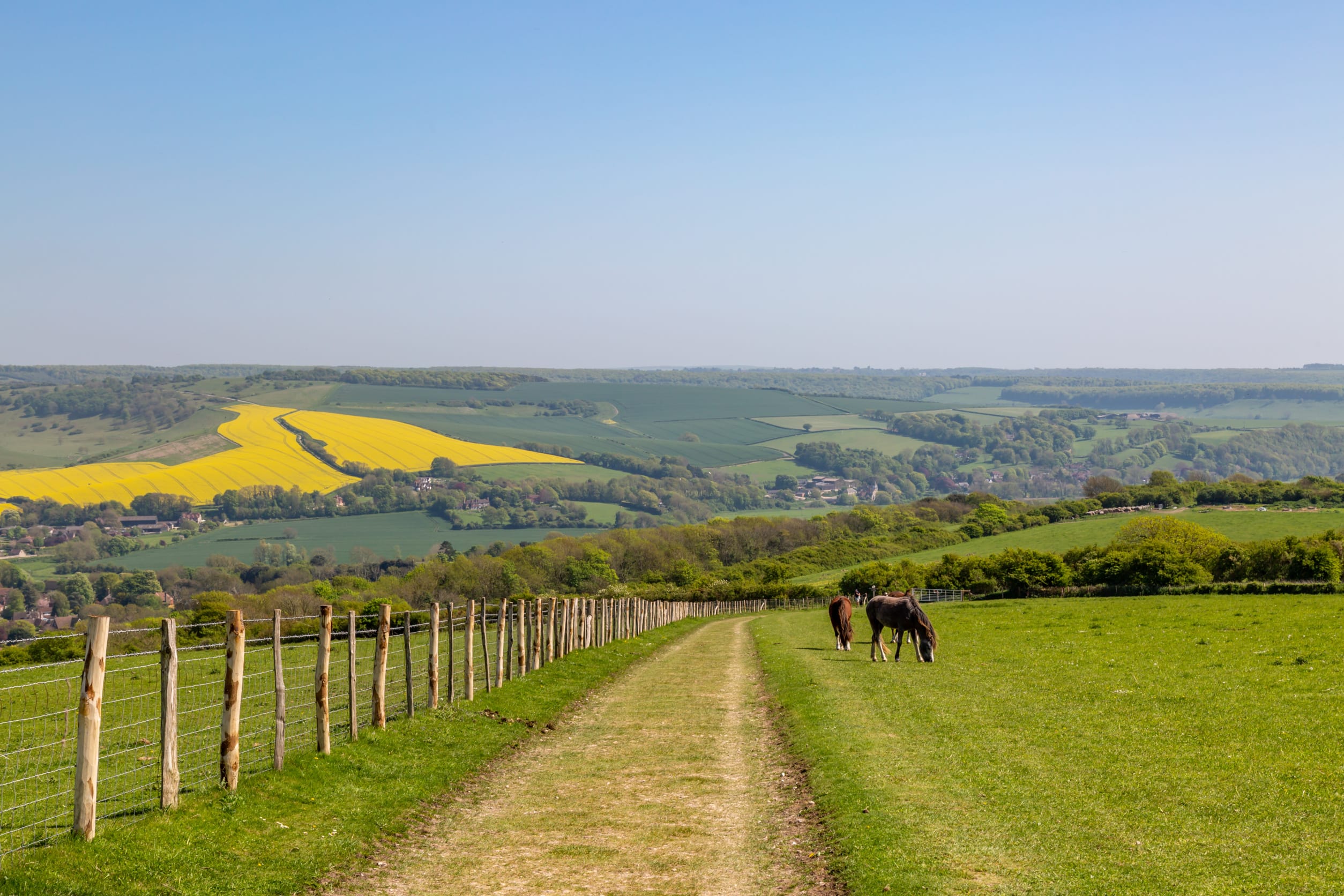
Sample South Downs Way Itineraries
The following are examples of Hillwalk Tours Gentle, Moderate and Challenging itineraries of hiking the South Downs Way.
Gentle 5-Day
Day 1: Arrival in Lewes
Day 2: Lewes – Southease (11km or 6.8 miles)
Day 3: Southease – Alfriston (16km or 9.9 miles)
Day 4: Alfriston – Eastbourne (17km or 10.6 miles)
Day 5: Departure from Eastbourne
Moderate 7-Day
Day 1: Arrival in Amberley or Arundel
Day 2: Amberley – Steyning/Bramber (23km or 17km – 14.3 or 10.6miles)
Day 3: Steyning/Bramber – Pyecombe (19 or 14km – 11.8 or 8.7miles)
Day 4: Pyecombe – Kingston-near-Lewes (19km – 11.8miles)
Day 5: Kingston-near-Lewes – Alfriston (19km – 11.8miles)
Day 6: Alfriston – Eastbourne (17km – 10.6miles)
Day 7: Departure from Eastbourne
Challenging 9-Day
Day 1: Arrival in Winchester
Day 2: Winchester – Meon Springs (30-27km – 18.6-16.8miles)
Day 3: Meon Springs – Cocking (32km – 19.9miles)
Day 4: Cocking – Amberley (19km – 11.8miles)
Day 5: Amberley – Bramber (23km – 14.3miles)
Day 6: Bramber – Lewes (28km – 17.4miles)
Day 7: Lewes – Alfriston (22km – 13.7miles)
Day 8: Alfriston – Eastbourne (17km – 10.6miles)
Day 9: Departure from Eastbourne
Hillwalk Tours Map
South Downs Way Terrain
Waymarking
The South Downs Way is well signposted throughout. You will see the distinctive acorn symbol on stiles, gates, signposts, and lampposts through towns. This is the symbol used by each of the National Trails throughout England and Wales. Although there are several routes you can take through towns and villages, the official route is signed with white acorn waymarks that are sometimes stuck high up on lampposts and other street furniture.
If you are ever in doubt, you can also check the Hillwalk Tours turn by turn directions and route notes including GPS coordinates. We also supply all you need to know about local information and history as you pass, along with trail alternatives and other activities.
Want to learn more about how to read a map? Check out this blog post.

Difficulty
The South Downs Way is considered to be one of the easier National Trails to walk and it is said that anyone who with reasonably fitness can complete the trail. However, there is a bit of ‘up and down’ terrain on every section of the route as the trail follows the undulations of the rolling hills and climbs, in and out of the river valleys. Walkers also have to make their way to and from their accommodations at the foot of the Downs.
For almost the entire walk the trail follows good tracks, paths and open grassland, suitable for hiking as well as mountain bikes. Hiking along a chalk ridge means that, as a rule, much of the trail drains well and dries out quickly, i.e. the surface is good all year round with few wet or muddy sections after rain. But in a few places the chalk tracks have been eroded so that the flintstones, which are embedded in the chalk, break through the surface you walk on. This can be hard on your feet and we recommend shoes or boots with good soles to help with walking on those surfaces. Hiking poles can also help here, as well as with the ups and downs, as they take some of the weight of your feet.
Sights & Attractions
Seven Sisters
The magnificent Seven Sisters cliffs, in East Sussex, are part of England’s South Downs National Park. The cliffs stretch along the Sussex coast in the East Sussex Downs Area of Outstanding Natural Beauty (AONB). The walk is one that every hiker should add to their bucket list this year!
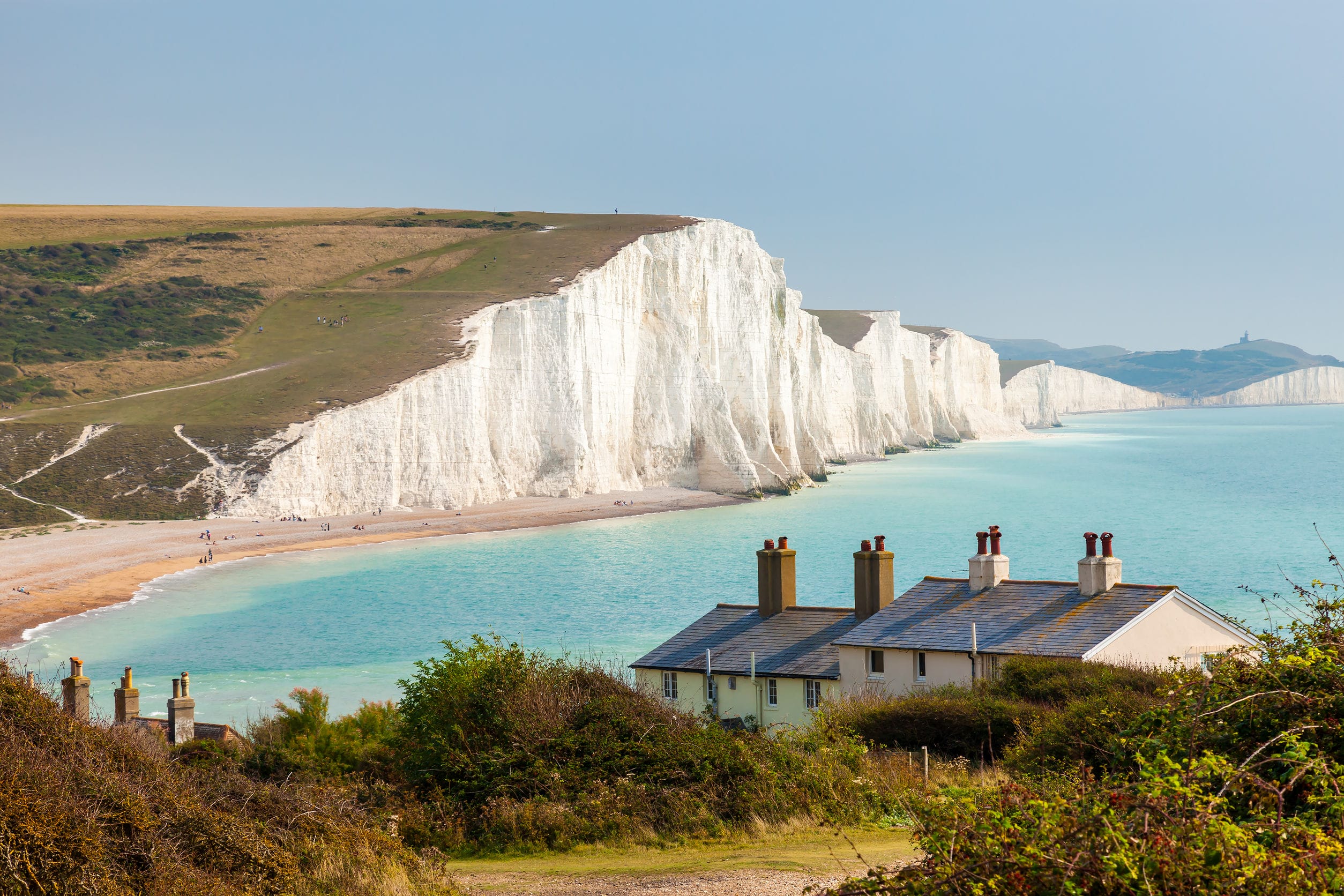
Beachy Head
Beachy Head is a chalk headland in East Sussex, England. It is situated close to Eastbourne and east of the Seven Sisters. The cliff is the highest chalk sea cliff in the UK, standing at 162 m (531 ft) above sea level. From here, you can also feast your eyes on the Beachy Head lighthouse which is located just below the cliff.

South Down’s National Park
The South Downs National Park is a tranquil oasis that boasts magnificent flora and fauna. From the luscious green rolling hills to the outstanding Seven Sisters, the South Downs National Park’s landscapes cover 1,600km2 of beautiful and breath-taking views of the marvelous English countryside.
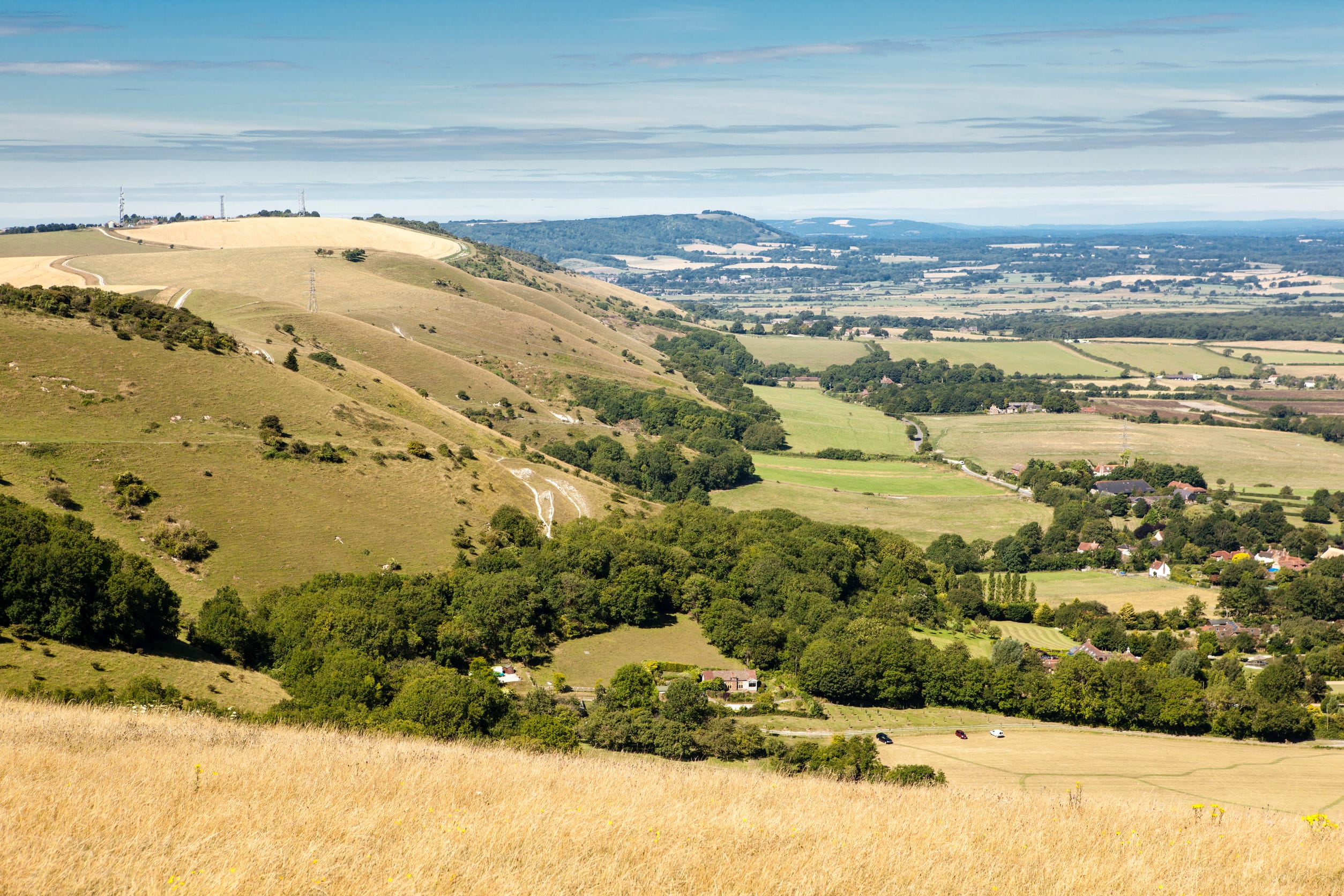
Winchester Cathedral
The Winchester Cathedral is among the largest of its kind in Northern Europe. The cathedral was built between the years of 1079 to 1532. With an overall length of 558 feet (170 m), it is the longest medieval cathedral in the world. The cathedral attracts more than 100,000 visitors through its doors each year.
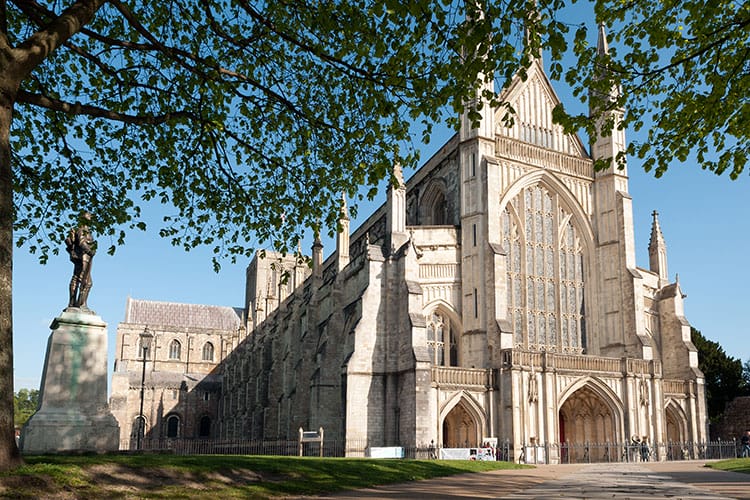
Old Winchester Hill Iron Age Fort
The Old Winchester Hill Iron Age Fort offers one of the most beautiful landscapes of the South Downs. The fort is encompassed by a bank and ditch and inside the fort, dips left from flint excavations and the rounded mounds of Bronze Age tumuli can be seen. Platforms on which huts and animal enclosures are still evident.
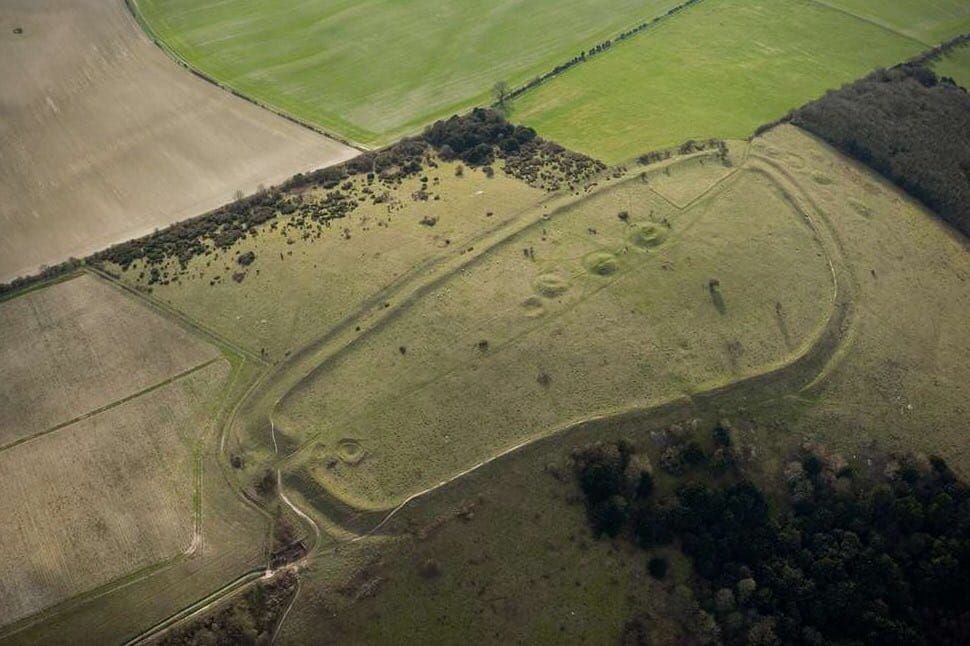
Chanctonbury Ring
Chanctonbury Ring is an Iron Age hillfort that was later used as a Roman religious site. The earliest known use of the site occurred in the Bronze Age, about 1500 BCE.
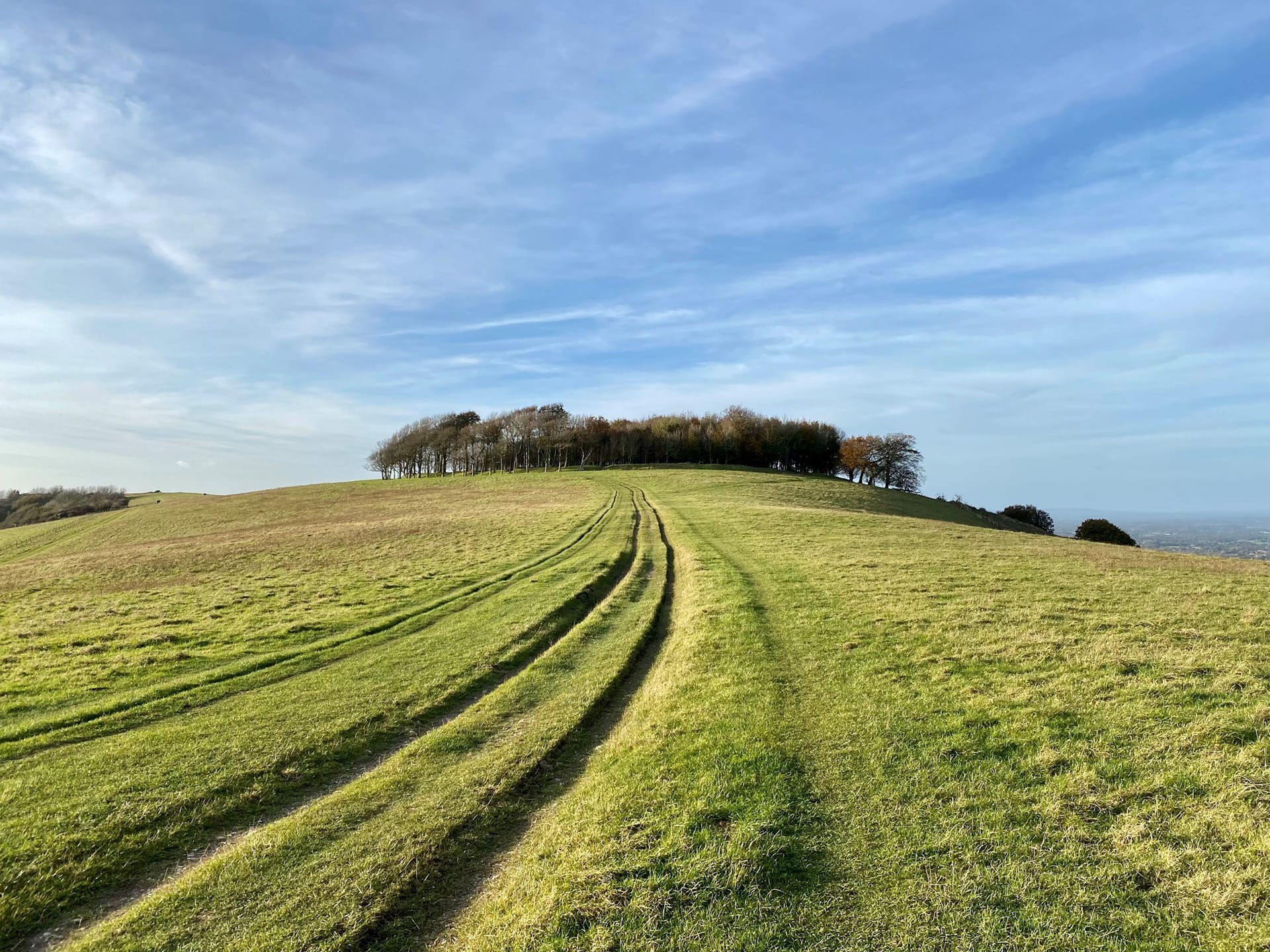
Devil’s Dyke Dry Valley
Experience one of the longest, deepest and widest dry valley areas in the UK. It was formed naturally over 10,000 years ago during the last Ice Age. Its magnificent landscape offers a perfect photo opportunity to make those who didn’t come on the walking holiday that little bit more jealous.
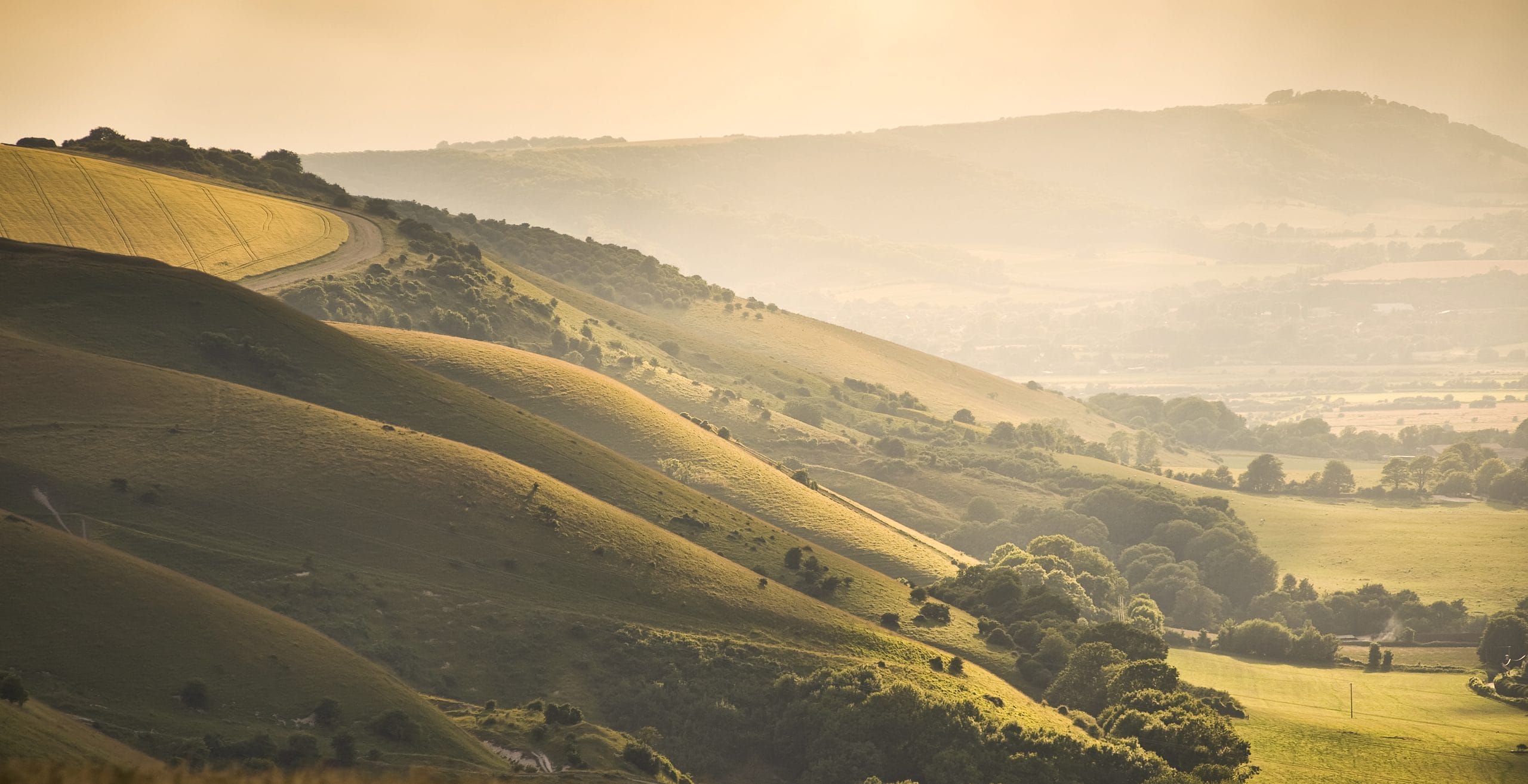
Wildlife
The South Downs Way boasts a wealth of wildlife throughout. The wildlife that can be spotted on the trail include, nightingales, green woodpeckers, over 39 species of butterfly, badgers, weasels, stoats, and roe or fallow deer. Other wildlife includes, around 23 species of dragonfly, elusive nightjars, adders, smooth snakes, great crested newts and sand lizards. You may also come across little grebes, sedge warblers, widgeons, Atlantic salmon, bullhead, grayling, brook lamprey and trout, along with water voles, otters and kingfishers. If you’re lucky you may be able to pick out some corn bunting, skylark, lapwing and grey partridge, birds, moths and glow-worms.

History of the South Downs Way
The South Downs Way trail has a rich, vibrant history and has been trekked for thousands of years. The area was occupied during the Neolithic era and remains of tumuli and forts can be seen along the South Downs Way today.
It was approved as a National Trail in March 1963 and officially opened in 1972. It was also the first bridleway National Trail in England. Historically, the route ran from Buriton to Beachy Head, but was later extended into Hampshire down to Winchester. The South Downs Way is one of a kind as it lies entirely within a National Park and is England’s newest National Park.
To celebrate South Downs Way’s 50th birthday on the 15th July 2022, a special commemorative plaque was produced for the 66 parishes along the 100-mile route.
Did you know?
In 2016 the South Downs Way National Park was granted International Dark Sky Reserve status, making it one of the best places in the country to view the night sky. Today, it is one of only 16 such Reserves in the world.
The South Downs Way Pop Culture
Film and TV
Atonement (2007)
Atonement is a 2007 romantic war drama film directed by Joe Wright and stars James McAvoy and Keira Knightley. The beach with chalk cliffs first shown on the postcard scene and later seen towards the end of the film was Cuckmere Haven, Seven Sisters, Sussex.

Harry Potter and the Goblet of Fire (2005)
The stunning Seven Sisters cliffs were used for spectacular shots where Harry Potter walks up the hill to find the boots that transport him to take part in the Quidditch World Cup.

The Living Daylights (1987)
The Living Daylights is a 1987 spy film, the 15th entry of the James Bond series. The iconic scene of the Land Rover falling into the water was set in Gibraltar but was actually filmed in Beachy Head near Eastbourne.

Angus, Thongs & Perfect Snogging (2008)
The coming-of-age drama follows the lead character, Georgia, a bright and shy girl who isn’t the prettiest schoolgirl on her pastel-painted terraced street in Eastbourne, but nevertheless, dreams of snagging the perfect boyfriend.

Mr Holmes (2015)
Set during his retirement in Sussex, the film follows a 93-year-old man, Holmes, who struggles to recall the details of his final case because his mind is slowly deteriorating. The Seven Sisters were used as a location.
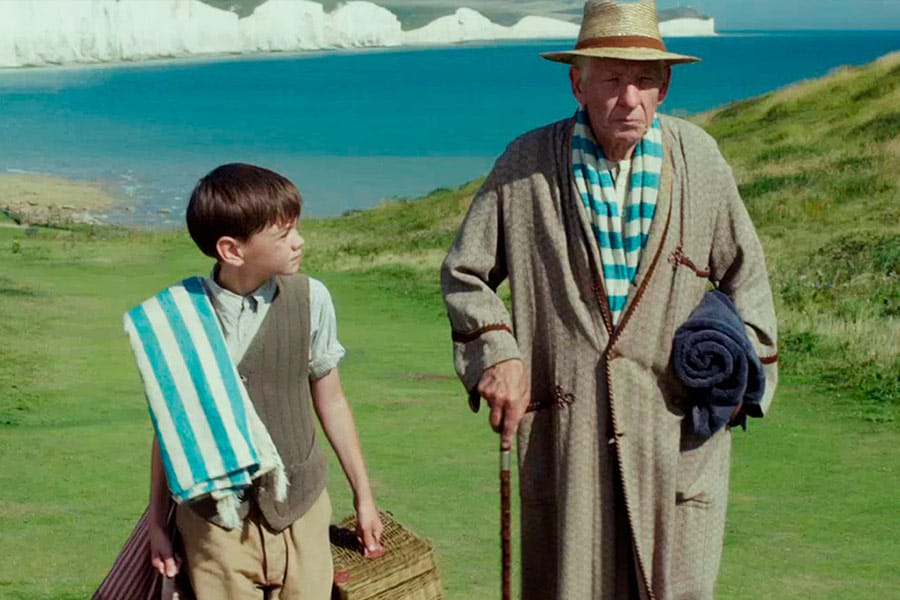
Food and Drink
Below are just some of the food and drink synonymous with the country of England that should be tried while walking the South Downs Way:
Yorkshire Pudding
Yorkshire pudding is a baked pudding made from a batter of eggs, flour, and milk or water. A common British side dish, it is a versatile food that can be served in numerous ways depending on its ingredients, size, and the accompanying components of the meal.

Fish and Chips
Fish and chips is a hot dish consisting of fried fish in batter, served with chips, peas and tartare sauce. The dish originated in England.

Full English Breakfast
This dish is aptly named the “full English breakfast.” Enjoy a full platter for the most important meal of the day, which typically consists of bacon, sausage, eggs, beans, toast, mushrooms, and tomatoes.

Toad in the Hole
‘Toad in the Hole’ or sausage toad is a traditional English dish consisting of sausages in Yorkshire pudding batter, usually served with onion gravy and vegetables.

Steak and Kidney Pie
Steak and kidney pie is a popular British dish synomnous to England. It is a savoury pie filled principally with a mixture of diced beef, diced kidney and onion. A perfect choice following completing your daily hours of hiking!

Scotch Egg
A Scotch egg is a boiled egg wrapped in sausage meat, coated in breadcrumbs and baked or deep-fried. Although it originated in Scotland, it can be found on most menus throughout England.

English Breakfast Tea
English breakfast tea is a black tea blend usually described as full-bodied, robust, rich and blended to go well with milk and sugar. Tea is so popular in England that tea-rooms are more easily found than coffee-shops!

Pimm’s
Pimm’s is a very popular English brand of gin-based fruit cup but may also be considered a liqueur or the base ingredient of a sling or punch cocktail. It’s widely regarded as Britain’s quintessential liqueur and a Pimm’s ‘Lemonade’ is a quite refreshing drink to have after a long day of hiking.

Is the South Downs Way Vegan Friendly
The vegan diet has become more and more popular throughout Europe in recent years, and you will find that there are plenty of vegan options available in most eateries. Each of the accommodation we work with at Hillwalk Tours have given us their guarantee that vegan breakfasts will be catered for once they have been informed. That being said, some of the more rural locations of the trail may have limited options so we advise bringing certain items such as plant-based milk, nut butters or protein powders if you so choose.
In addition, the following apps show restaurants which offer vegetarian and/or vegan opions:
Nearby Trails
There are various other UK trails available to you once you have completed the South Downs Way. Here are some nearby hiking tours we offer:
South Downs Way Path Tips and FAQs
Probably one of the most common questions asked when walking the South Downs Way or any trail for that matter is – what will I pack? Once you have fully booked your Hillwalk Tours hiking holiday, you will receive a detailed ‘recommended equipment’ list inside your Walking Pack. For those who are still unsure of what to bring, here are some of the things we advise you bring with you along the trail:
– Waterproof Clothing
– Fleece and other warm clothing
– Base Layer
– Light, comfortable Trousers
– Wicking Socks
– Suitable Hiking Boots
– Backpack/Rucksack
– Hat and Gloves
– First Aid Kit and Foil Blanket
– Whistle and Torch
– Insect Repellent
– Mobile Phone
– Plug Adapter/Converter
For more on what to pack – check out these packing musts.
Our 7-Day tours include 5 days of hiking. The first and last days of all our hiking tours are travel days used to transfer to/from the town where your hike will begin/end. If you would like to hike for 7 days, simply select one of our 9-Day tours.
A single supplement is an additional charge for walkers booking single accommodation (a room for one person). The total tour price per person requesting a single room is the price per person plus the single supplement. The supplement covers the extra costs associated with accommodating a single person in their own room.
It is not possible to bring your dog on Hillwalk Tours hiking holidays. Unfortunately, the majority of our accommodation providers do not accept pets of any kind.
No, on all of our hiking tours, your luggage will be transported to your next accommodation each day as you walk and will arrive before 4pm. A maximum weight limit of 20 kg per person applies to this luggage transfer service.
You will be staying in traditional English Bed & Breakfasts (B&B’s) and small guesthouses and hotels during your hiking trip. To ensure your comfort, each of the accommodations you will stay in has been personally checked by a member of the Hillwalk Tours team. You can expect a warm welcome, en-suite facilities (where available) and a hearty breakfast each morning. For more details on the accommodation you will be staying in, see the Accommodation section for each of the tours we offer.
– Route notes (prepared by a member the Hillwalk Tours team who has walked every step of your tour)
– Detailed hiking maps
– Waterproof map-case
– A sneak-peak at where you will be staying
– Our tips on the most interesting attractions to visit along the trail
– A look at fascinating local history
– A guide to the best places to eat and drink
– Mountain safety information, emergency contact details and the country’s phone prefix
We believe that the beauty of the English countryside should be enjoyed by everyone. With this in mind, we designed our hiking tours to cater for practically all levels of fitness. Our range of ‘Gentle’, ‘Moderate’ and ‘Challenging’ hikes in most regions allows you to decide how far you wish to walk each day. So, whether you are a novice walker or an experienced hiker, we have the tour to suit you.
Euros are not accepted anywhere in England – the currency used is the Pound Sterling (£).
The South Downs Way Image Gallery
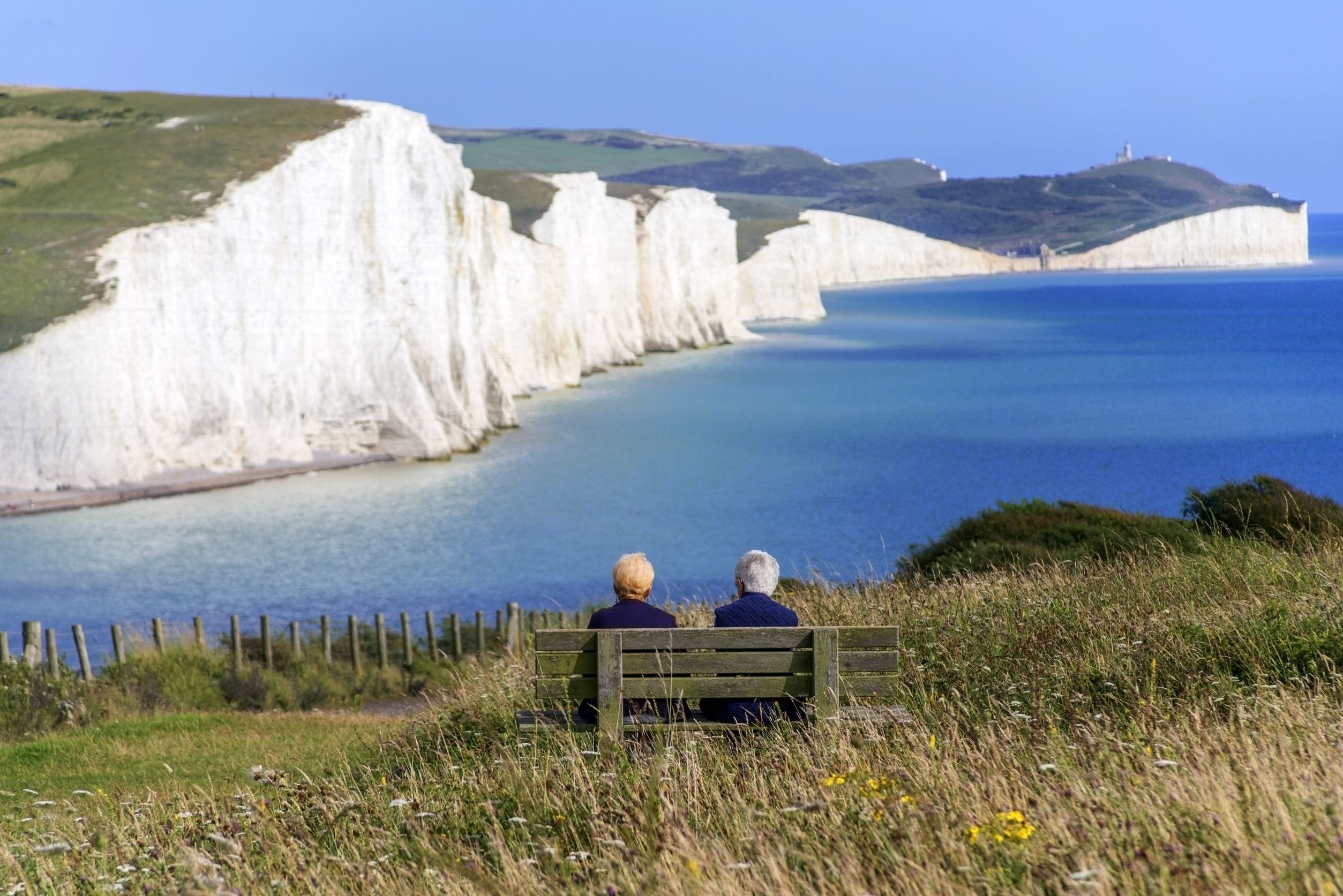
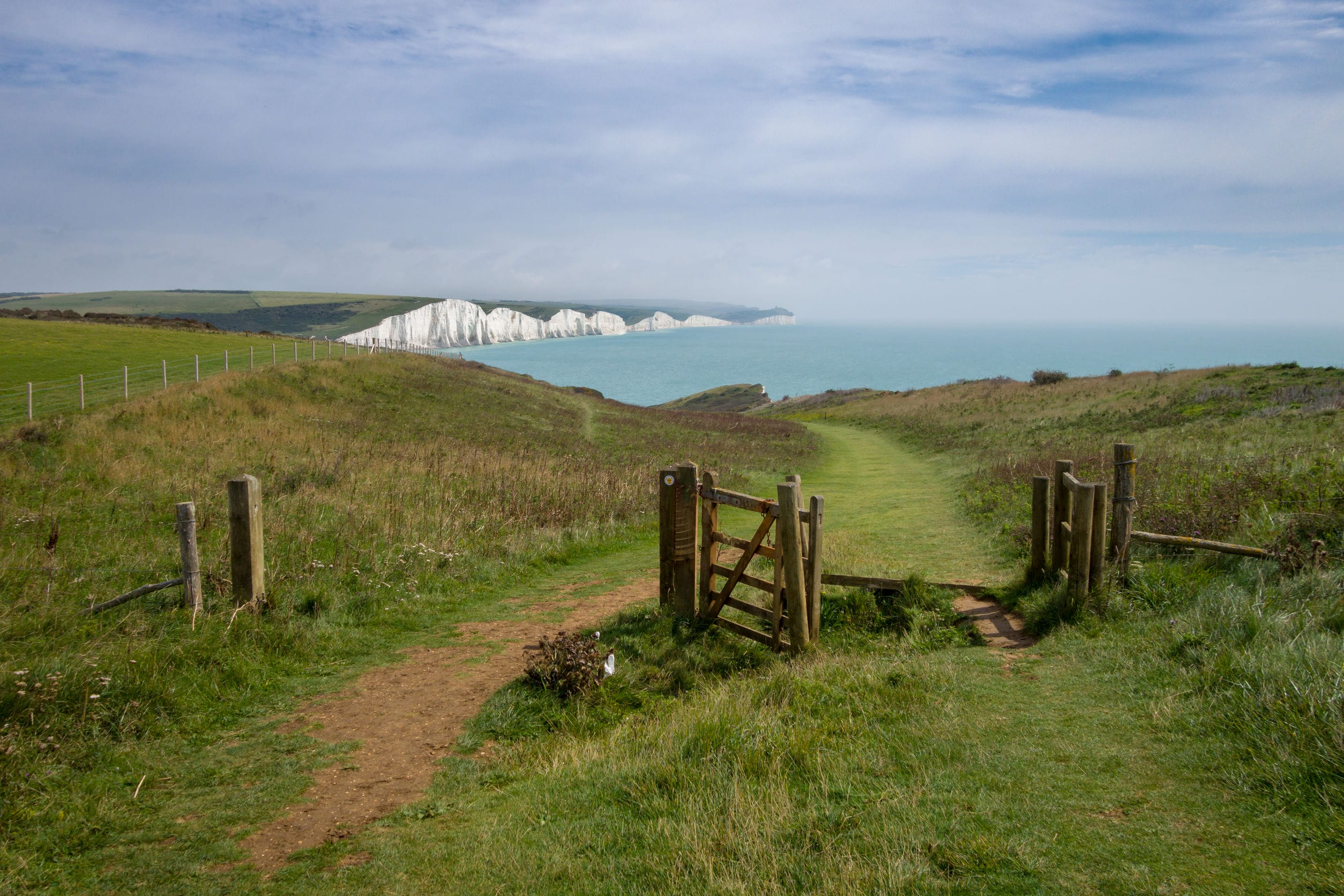

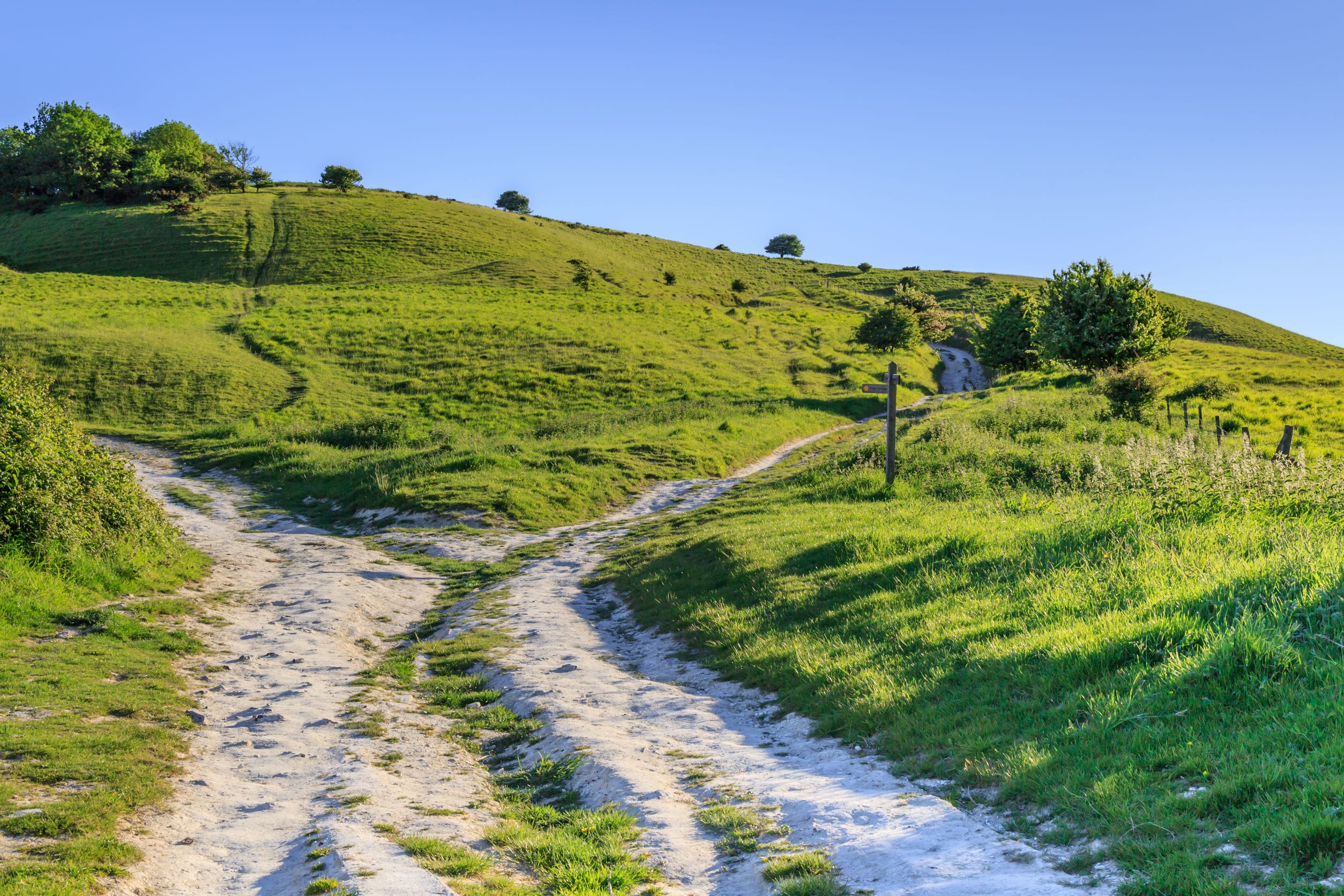
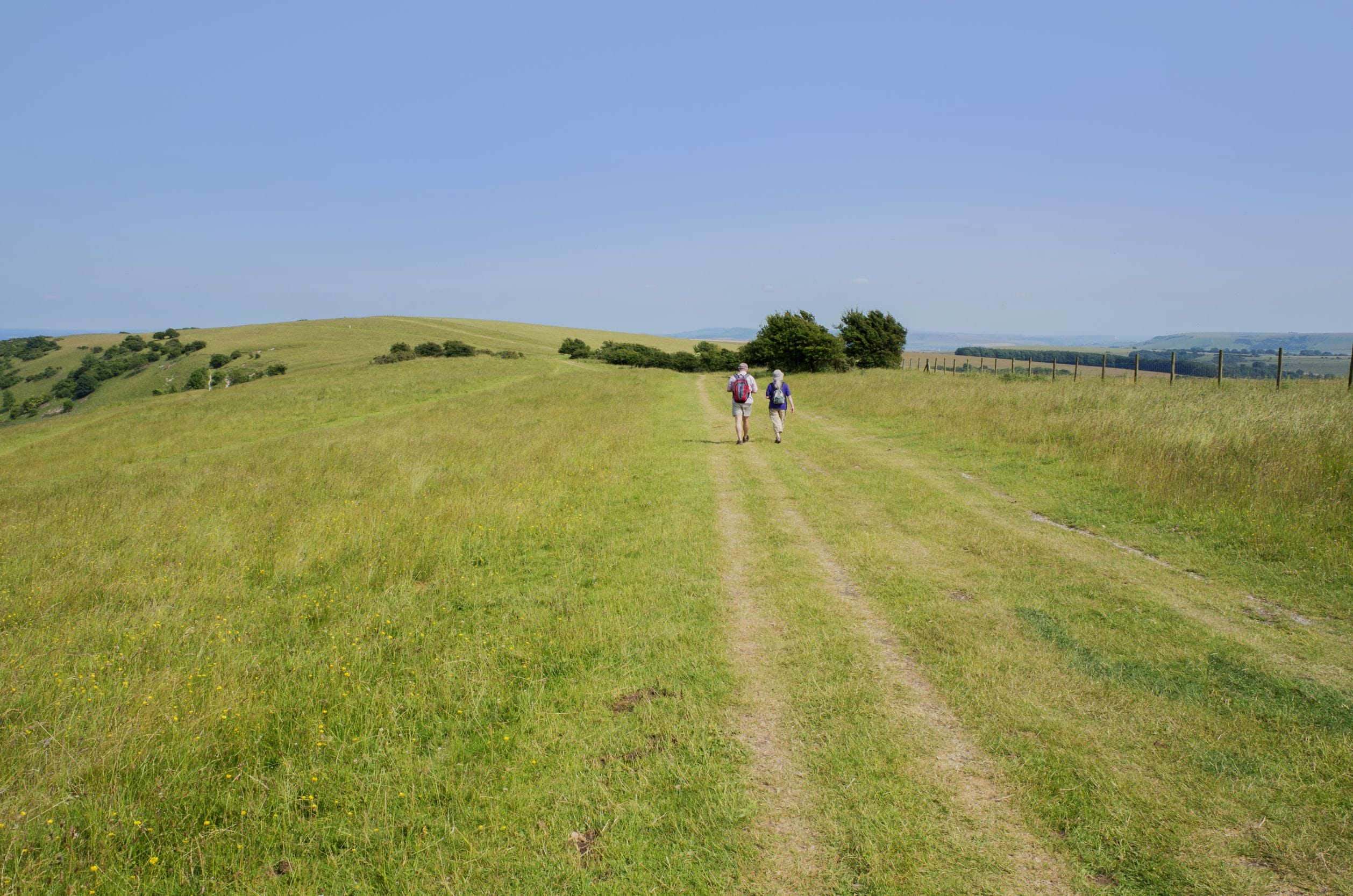
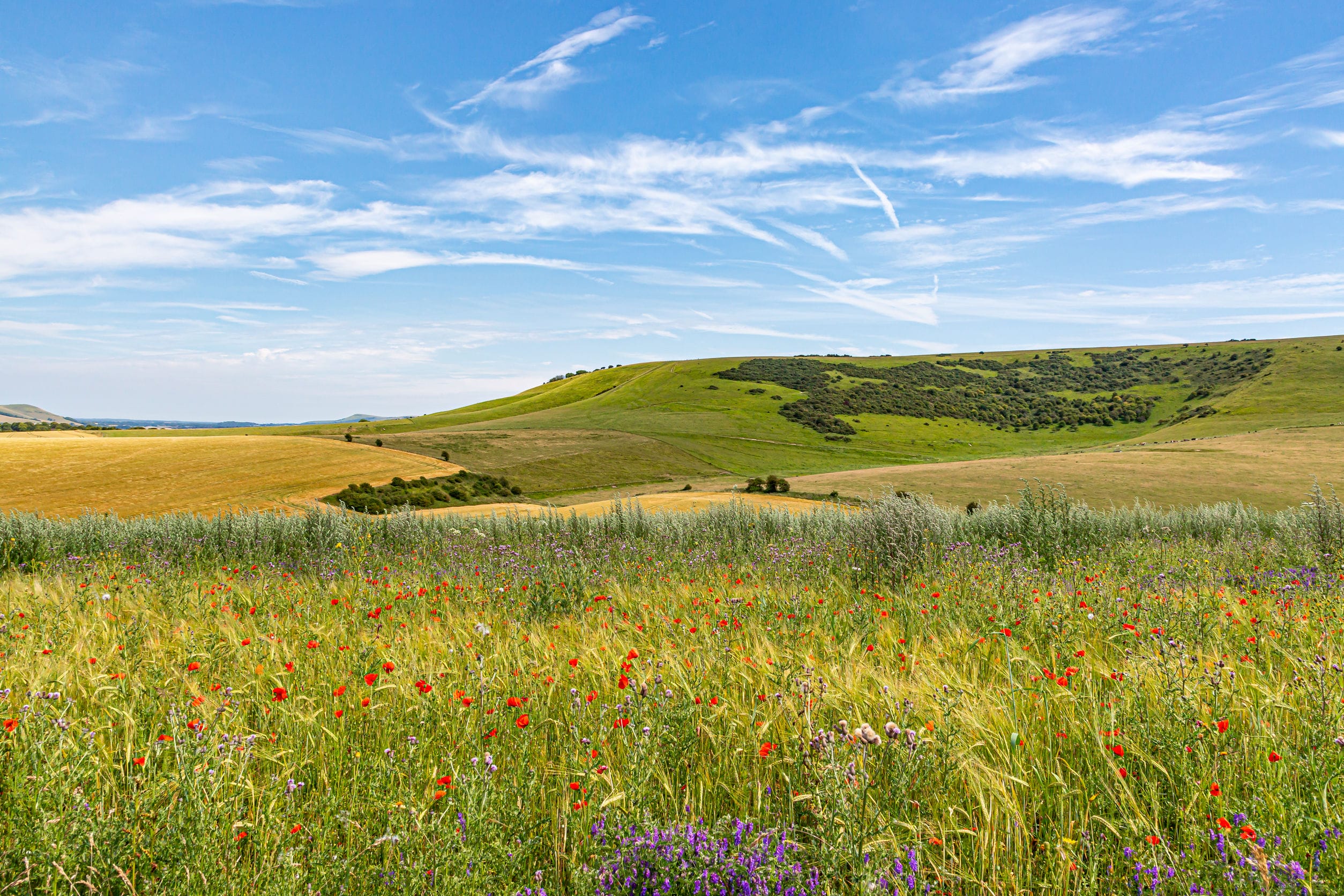
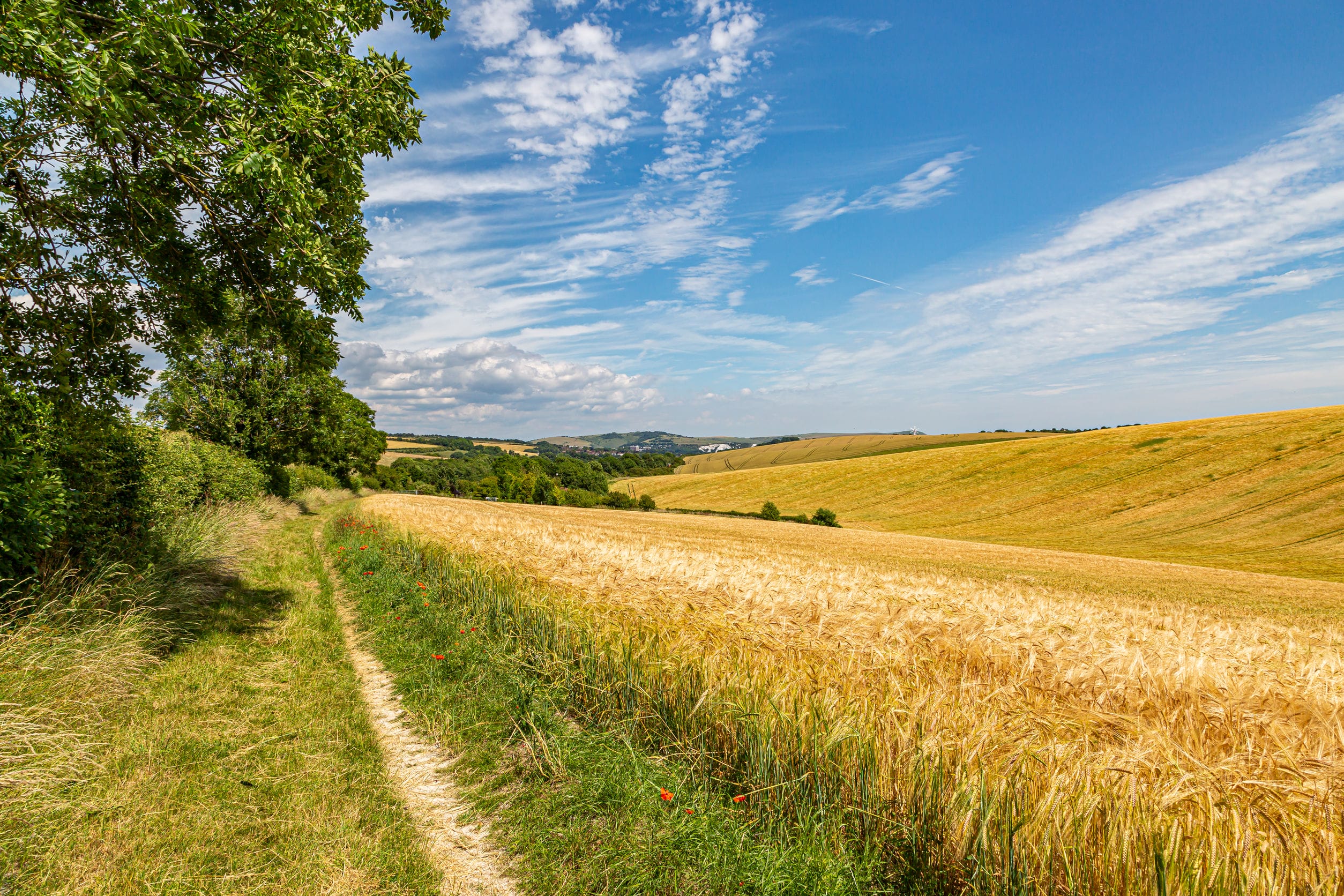

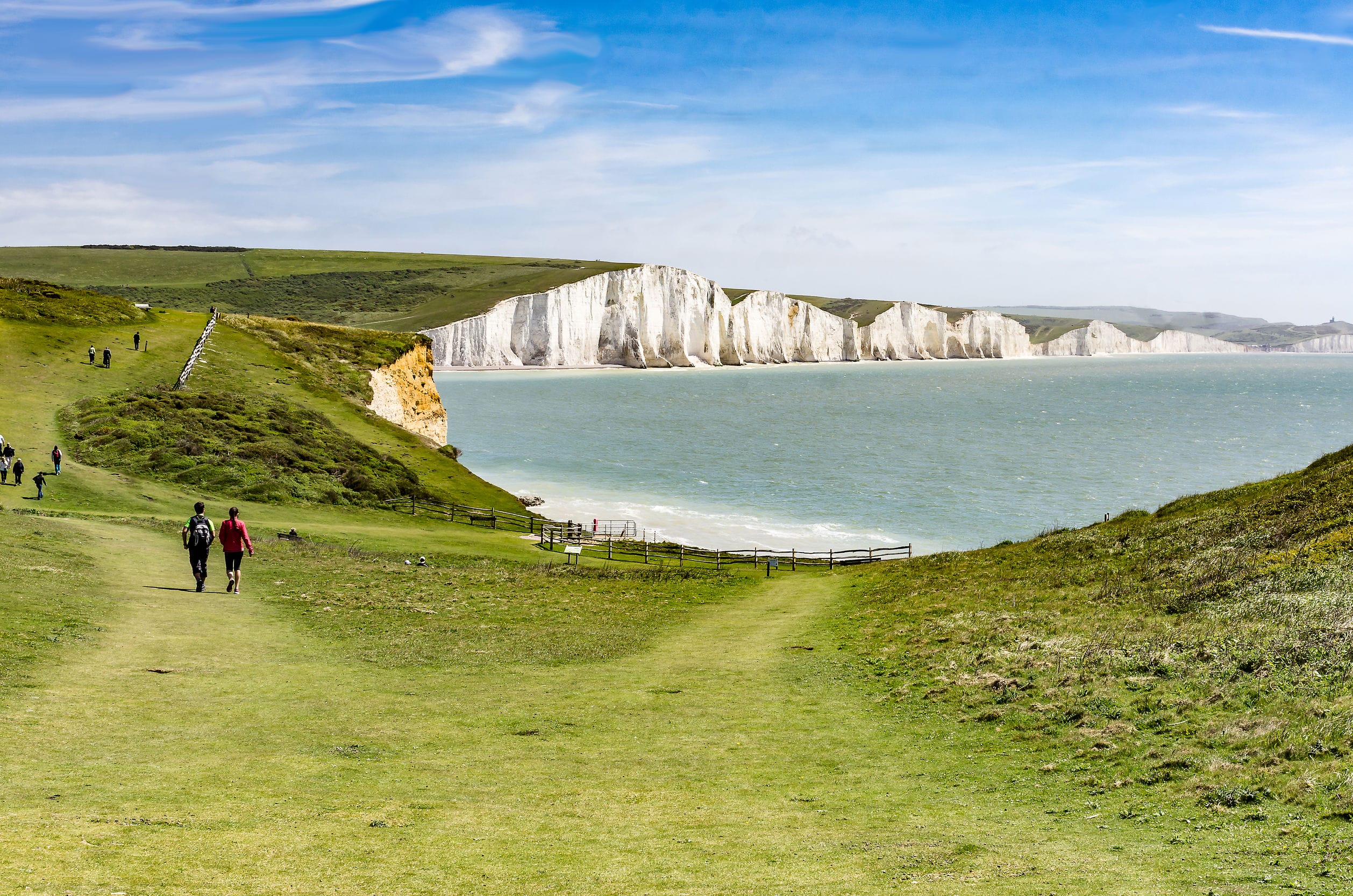
Hillwalk Tours
About Us
Hillwalk Tours is an award-winning walking tour operator which specialise in self-guided walking holidays in Ireland, Scotland, England, Wales and along the Camino de Santiago in Spain. Our goal is to create happy experiences for all of our customers, suppliers & staff.
Fill out the form below with any questions you may have and we will get back to you promptly.
Follow us on our social media platforms
Leave No Trace
We like to walk in nature and since you are reading this – we believe you do too! It is important to ensure that our impact on the environment is limited so that hikers can enjoy the same view after us. The rule applies: when you leave, make sure that nature looks the same as when you arrived or simply put “leave no trace.” As more and more people take to the great outdoors, our collective mark on the environment increases.
What does this mean in reality? Of course, do not leave any rubbish or waste behind. Do not collect stones, flowers, or other “souvenirs”. Don’t carve your name on a tree or break branches… I think you get the drift. It is imperative for walkers to play their part in making sure litter, damage to vegetation and all forms of pollution are limited.
Noise can also be a form of pollution. Whoever walks through a forest talking and laughing loudly, for example, ruins the peace and quiet of other walkers, who can no longer hear the birds. The same goes for cell phones that suddenly start ringing. Keep the volume down and respect your surroundings. Ultimately, the point is to ensure that as many people as possible can enjoy walking through nature. So that applies to you, but also to those who tread the path after you.
Hillwalk Tours proudly supports sustainable tourism and loves the countryside as it is – wild, peaceful and clean. We are proud to support the “Leave No Trace” initiative that aims to preserve the natural beauty of each nations countryside where we offer hiking holidays. We try to create happy experiences for our accommodation too, and the restaurants, shops and taxi companies that serve our walkers. These are often small businesses located in isolated areas that have been left behind by urban migration and a lack of investment in rural regions. Their warm hospitality and friendly welcomes epitomise the magic of a Hillwalk Tour and we’re dedicated to helping keep these rural communities alive.
The Benefits of Hiking
In recent years, walking and hiking outdoors has been widely reported to have numerous physical and mental health benefits. The following are examples of some of these benefits:
Improve strength and fitness
- Weight loss
- Muscle gain
- Improve metabolism
- Improve digestion
- Better quality sleep
- Increase in Vitamin D
- Improve discipline
- Sense of achievement
- Living in the present moment
Hiking Equipment List
For a more in-depth list of recommended hiking equipment list, click here.


